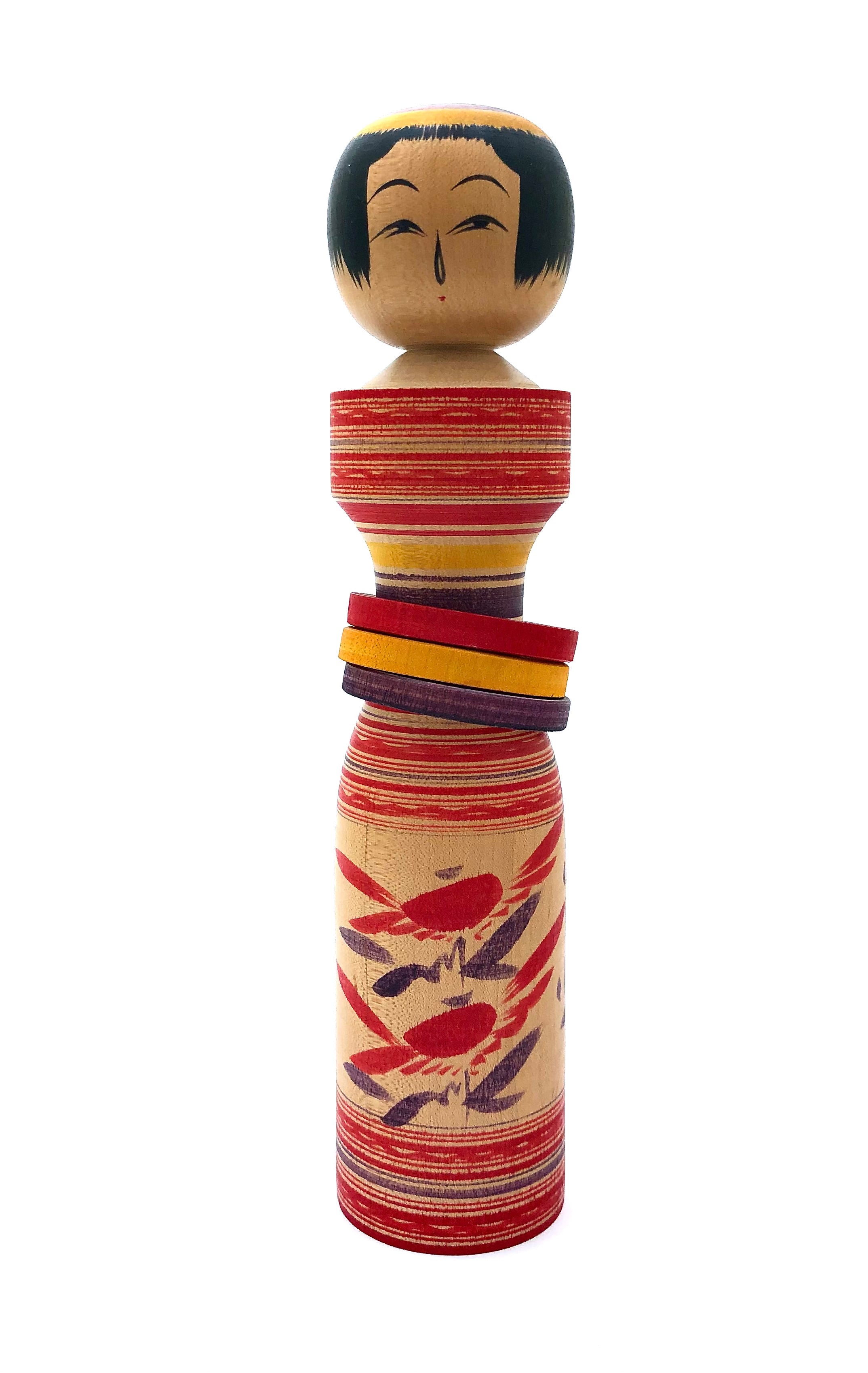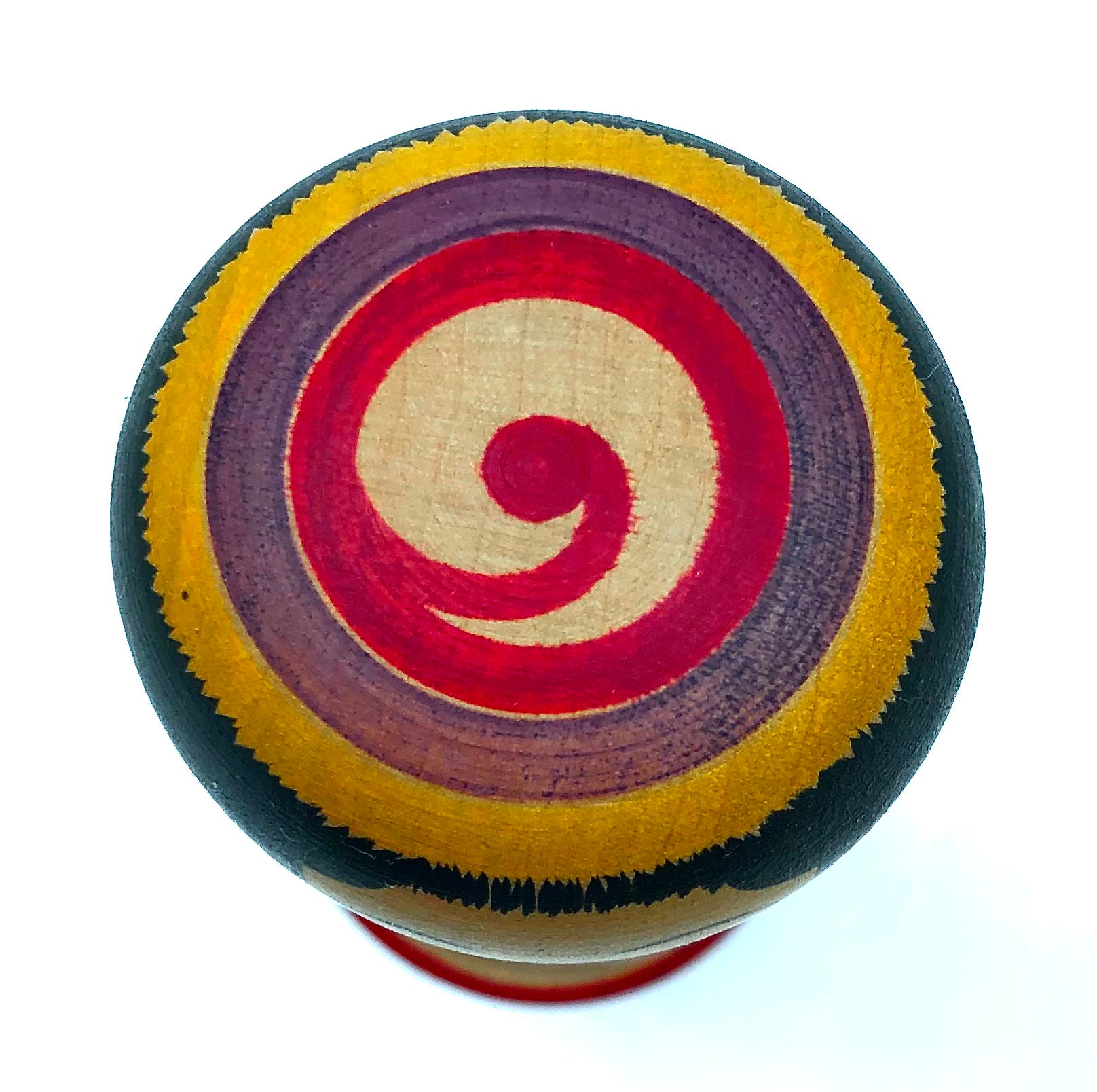


Vintage Traditional Sakunami Style Kokeshi with Rings by Hiraga, Teruyuki
Dimensions: 9-0”h
Unique to this strain and a rare find is this Kokeshi produced by the Hiraga family originating in Sakunami and who continued producing the same style doll when the other families producing this type of Kokeshi moved in two different locations. This particular style and doll is one of the older Kokeshi forms, as they date to the early Meiji period, (1868-1912).
This Kokeshi is made of one piece of Mizuki, a very pale, fine-grained variety of dogwood, which grows in the Yamagata area. As seen here are Plum and crab-flower blossoms which dominate the body design. The flowers are painted in red and purple with a very bold, stylized design and painted ‘Yoko mono’ bands throughout the body. The dolls have disproportionately smaller head. It specifically was designed to be a hand-held toy, rather than a freestanding doll. The unique feature is that incorporated into the body and made of the same piece of wood are three loose rings of red, yellow and purple. The head incorporates the double eye lid and the Sakunami tear drop nose, with ‘bob’ style hair design with a decorative red and purple circular motif on the top.
Vintage Condition: Excellent, unrestored and completely intact and retains the original craft/workmanship. The piece meets all the standards of collectible Folk Art.

Japanese Traditional Kokeshi
Yamagata-Sakunami-Kei (Family)
Prefecture: Miyagi
Origin:
Unique to this strain of the original ten traditional types is the fact that the Yamagata Kokeshi originated at Sakunami Onsen in Miyagi Prefecture, and was produced by the Kobayashi family. The family later moved to the city of Yamagata in the prefecture of the same name. However, the Hiraga family stayed in Sakunami and continued producing the same style doll, which is why these Kokeshi are made in two different locations. Because there are two very different body shapes in this group, many people consider them separately, but due to the confusion over who actually created the first of this type, we will discuss them as one family.
Collector's note – characteristics/painting style:
The dolls have disproportionately larger heads, but while the Yamagata doll has a very slender body, the later Sakunami dolls have wide upper bodies, and very narrow bases. Both look quite top-heavy, leading some people to assume that originally they were much smaller, and designed to be hand-held toys, rather than freestanding dolls. Both strains are made of one piece of wood with faces that incorporate two lidded eyes as well as a single-lid on top of the eye. The mouth is usually two short parallel lines, with some having a red line with a red dot below. Plum, (Ume), and crab-flower chrysanthemum, (Kiku), blossoms dominate the body design. Additionallly, Safflowers are seen, and are considered unique to this strain. The flowers are usually painted in a very bold, stylized design in colours of red and dark green, and also painted or grooved bands ringing the top and the bottom of the dolls. The hair is pulled nto a single “braid” that is t ied with a circular red ribbon with radiating ends. Some dolls have hats similar to the conical (Suge-gasa) hat that incorporates “chattering” rather than painting giving them texture. Most have traditional half-moon shaped bangs and tufts, or side hair fringes framing the face. Indeed, these dolls are one of the older Kokeshi forms, as they date to the early Meiji period, (1868-1912). A final unique feature of the Sakunami dolls is the fact they are only made from Mizuki, a very pale, fine-grained variety of dogwood, which grows in the Yamagata area.

Leading, Craftsmen:
Abe, Masayoshi, 1939- No additional published information
Hayashaka, Dinkichi - No additional published information
Higara, Teizo, 1897-1992 - No additional published information
Hiraga Tadashi, b. 1937, (Sakunami, Miyagi) - Masters: Hiraga Kenjiro, 1918, (Sakunami, Miyagi) - Master: Hiraga, Kenjiro, 1918-2012 - No additional published information
Hirose, Shigeo, 1926, (Mikura-jima, Tokyo) - Master Suzuki, Shoji. No additional published information
Kobayashi, Koutaro, 1936, (Yamagata) - Master: Kobayashi, Eizo. No additional published information
Kobayashi, Eizo, Master, 1907 (Yamagata) - Masters: Koyabashi, Kuraki-chi and Kobayashi, Seizo - No additional published information
Kobayashi, Seitaro, Grand Master, 1926-2005, (Yamagata) - Master: Kobayashi. No additional published information
Kobayashi, Seijiro, 1918-2015 - No additional published information
Okuyama, Kozo, 1905-1984, (Kahoku, Yamagata) - Master: Okuyama, Yasuji. No additional published information
Shida, Kikumaro, 1892-1984 - No additional published information
Satomi, Masao, 1922-1981 - No additional published information
Shido, Shozan, 1932-1995. No additional published information
Umezu, Haruo, 1926, (Yamagata) - Master Kanayama, Buntaro. No additional published information
Explore & Learn More about Yamagata-Sakunami-Kei (Family)